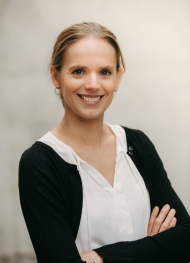The Neuro Killam Seminar Series: Laura de Laporte
 “Injectable Hydrogel with Unidirectional Architecture for Spinal Cord Injury Repair”
“Injectable Hydrogel with Unidirectional Architecture for Spinal Cord Injury Repair”
Dr. Laura de Laporte
Professor, University of Ghent, Belgium
Tuesday, April 4, 2023 – 4 p.m.
De Grandpré Communications Centre
To attend in person, register here.
To watch via vimeo, click here.
Host: Alyson Fournier
Abstract
For soft tissue regeneration, injectable hydrogels, which form a matrix in situ in a minimal invasive manner, are desired. They enable easy adaptation to irregular injury shapes and are capable of mimicking the molecular and mechanical cues of the extracellular matrix (ECM) found in native tissues. Nevertheless, most hydrogels currently lack control over their structural architecture after injection in the body, which is essential to guide and direct cells in complex tissues, such as the spinal cord. Therefore, we engineered an injectable biomaterial that forms an anisotropic, unidirectional matrix inside the patient’s body. The designed system is a hybrid hydrogel defined as Anisogel. A hydrogel precursor solution consists of micro-scale magneto-responsive short polymeric rods and is injected in the presence of a low external magnetic field (~mTesla). Different methods including in mold polymerization, a combination of high throughput spinning/microcutting, and continuous microfluidics are employed to produce the polymeric rods, which are rendered magnetic by incorporating a low amount of superparamagnetic iron oxide nanoparticles (SPIONs) inside the polymer solution before fabrication. After injection, the short rods orient in the direction of the magnetic field, while the surrounding precursor solution crosslinks to fix their position. This method enables the formation of a stable anisotropic architecture that is preserved after removal of the magnetic field. To test the potential of the newly developed material to direct nerve growth, dissociated primary neurons and full dorsal root ganglia are inserted before formation of the Anisogels. While hydrogels without or with randomly oriented short rods result in radially extending neurites, neurites grow in a unidirectional manner inside the Anisogel. In addition, the presence of short oriented rods within the 3D matrix enhances the rate of neurite extension, depending on the dimensions and aspect ratio of the rods. For the first time, we demonstrate that the Anisogel supports spontaneous neural signal propagation in the direction of the oriented rods. The simplicity, versatility, and parameter control of this technology, in combination with its low invasiveness has the potential to enhance the clinical outcome of patients suffering from spinal cord injury, without risking further damage caused by conventional treatments, such as implanting polymeric bridges. It can be easily combined with other therapies, based on cells, pharmaceutics, and rehabilitation.
Bio
Laura De Laporte designs biomaterials that control and direct the interaction with cells. She is a Chemical Engineer from Ghent, where she got the tissue engineering microbe. To follow her dream, she did her PhD at Northwestern University and Post Doc at EPFL. Currently, she is a Leibniz Professor at the RWTH University in Aachen, Germany, where she works on Advanced Biomedical Systems at the DWI-Leibniz Institute for Interactive Materials. In the ERC StG Anisogel, her team designs low-invasive, polymeric regenerative hydrogel therapies that orient after injection to repair anisotropic tissues. In addition, dynamic hydrogels are created to study mechanobiology.
Supported by the generosity of the Killam Trusts, the MNI’s Killam Seminar Series invites outstanding guest speakers whose research is of interest to the scientific community at the MNI and McGill University.
